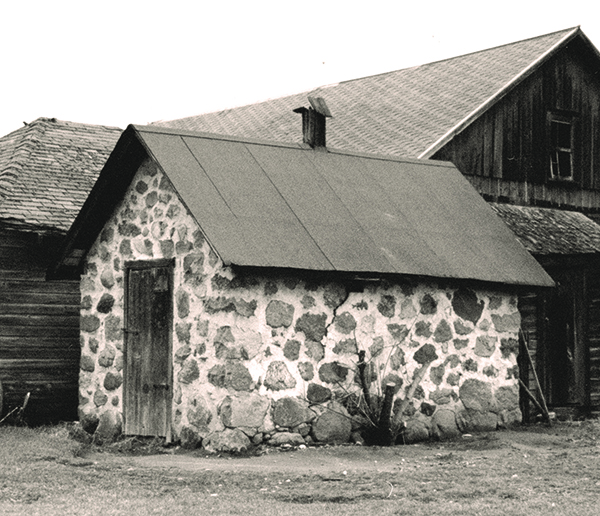The late, great R.W. Apple, longtime writer and editor of the New York Times, once called Nueske’s Applewood Smoked Bacon “the beluga of bacon, the Rolls-Royce of Rashers.” What impressed him—and frankly, impresses me, too—was the bacon’s balance. It’s intensely porky, nicely smoky, never too salty, with a slightly maple-sweet flavor. There are a lot of things that contribute to the flavor, from the kind of hogs used to what they’re fed to the curing method to the proportion of sugar, salt, and spices in the rub. Yet after one visit to the Nueske’s production facility in Wittenberg, Wisconsin, Apple had it figured out. He wrote, “the key to the flavor and consistency of Nueske bacon… lies in the smokehouse.”
Nueske’s has been building identical smokehouses for 80 years.
The original Nueske smokehouse stands in front of the company’s retail pork shop. It’s functional, but today it’s just for show. There are 32 smokehouses built to match it, though, and those are in use every day. They’re all built according to the same original plans—why mess with success? Many of them have been smoking for decades. As the smokehouses get older, the smoky aroma is more deeply ingrained, and they get better and better, like a well-seasoned cast iron pan.
Each smokehouse is about the size of a walk-in closet. You might be imagining a small village of tiny houses in the forest, chimneys puffing away, but these days the smokehouses are all indoors, in an enormous smoking room. They are watched by smokemaster Mike, who’s been overseeing the smoking at Nueske’s for more than twenty years. Mike will tell you that the smokehouses are each a little different, like children. Some are easy, some difficult, some unpredictable, some stormy. He has a couple of apprentices who have been training to operate the smokehouses for a few years now, but Mike retains the final say in the smoking. He says when each slab of bacon is done. Since each batch smokes for 24 hours and they smoke seven days a week, that means Mike is on call 24/7, you know, for smoking emergencies.
Inside the smokehouses, whole sides of bacon hang from special racks on wheels. The smoke comes from open fires built from applewood logs. The design is meant to help all the sides of bacon smoke evenly, but that’s about as much as I can tell you about it because that’s about as much as I know. The particulars of Nueske’s smokehouse workings are closely guarded company secrets. If you go and visit them, like Apple did, they’ll let you take a look—but you can’t take photos. If you just call to ask questions, like I did, the details are left largely to the imagination.
The Nueske family only smokes with applewood logs.
The recipe came from Wilhelm and Wilhelmina Nueske, who emigrated from Prussia to Wisconsin in 1887. Two generations later in 1933, R.C. Nueske, started selling applewood smoked meats made with the family recipe. The same recipe is still used today.
Smoking with applewood might not seem that distinctive, given how much bacon out there is labeled as “applewood.” But as Tanya Nueske, R.C.’s granddaughter and the fifth-generation bacon maker leading the company today, explains it, “‘applewood smoke’ can mean almost anything these days—apple juice, apple smoke flavoring, liquid smoke… But we only use real logs of Wisconsin applewood.” There’s a whole room in the Nueske’s production facility that’s filled with nothing but piles and piles of applewood logs, ready for smoldering and smoking. Using those logs creates a sweet, aromatic smoke that gives the bacon so much of its flavor. Using shortcuts like smoke flavoring or even applewood sawdust doesn’t give bacon the same depth.
Nueske’s smokes each batch of bacon for at least 24 hours. That’s much longer than the industry standard, which is an hour or two at most, if they smoke at all—many just pour on liquid smoke flavoring. That full day of smoking gives the sweet, smoky aroma time to totally penetrate the meat.
Most of the applewood comes from a couple of hours away in nearby Door County, Wisconsin. Door has thousands of acres of fruit orchards, and many of them are apple. Each year the trees are pruned and the byproduct is plenty of applewood. The abundance of orchard “waste” is probably what led Wilhelm and Wilhelmina to start smoking with it 130 years ago, but I bet they chose to keep smoking with it exclusively because they loved the flavor it imparts. Different woods give different flavors. Applewood smoke gives a subtle sweetness to the meat that balances incredibly well with the savory smokiness. Hickory, a common smoking wood in the South, gives a more intense, savory quality to the meat. Some bacon makers include smoke other aromatics, too, like juniper berries to give the bacon some piney notes.
Nueske’s Applewood Smoked Bacon has been the house bacon at Zingerman’s Deli for 33 years.
It shows up on our half-dozen versions of a BLT and atop a slew of other sandwiches. Pounds and pounds are fried up every morning alongside eggs for breakfast. It hasn’t stuck around just because we’re lazy. We taste new bacons every month—dozens in the past year—sent in by aspiring bacon makers around the country. Today we sell more than 20 different bacons. Our co-founder Ari has written an entire book on the subject. But for all of the bacons that we’ve tried and loved, Nueske’s Applewood Smoked Bacon has remained the standard by which all others are judged. It’s been our staff favorite and customer favorite for three decades. I don’t expect things will be any different three decades from now.

